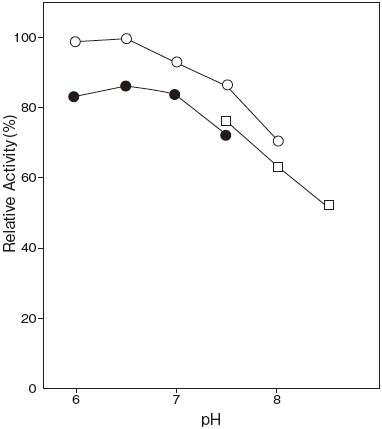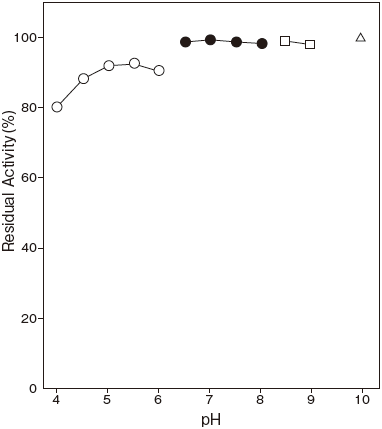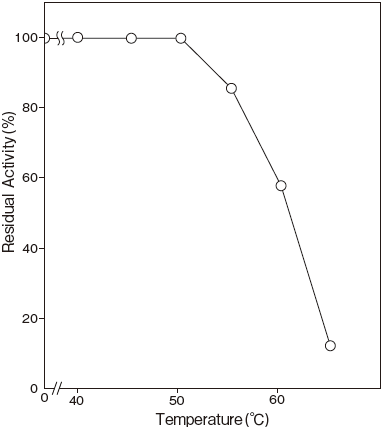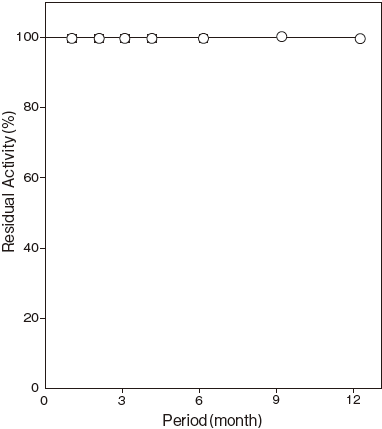CHOLESTEROL ESTERASE [CEN]
from Pseudomonas sp.
(Steryl-ester acylhydrolase, EC 3.1.1.13)
(Sterol esterase)
Cholesterol ester + H2O → Cholesterol + Fatty acid
Preparation and Specification
- Appearance
- : White to pale brownish amorphous powder, lyophilized
- Specific activity
- : More than 100 U/mg solid
Properties
- Substrate specificity
- : See Table 1
- Molecular weight
- : 29.5 kDa (SDS–PAGE)
31.0 kDa (Sephadex G–100)
- Isoelectric point
- : pH 4.25
- Michaelis constants
- : Cholesterol linolate 1.28 × 10-3M
Cholesterol ester of calf serum 7.5 × 10-4M
- Optimum pH
- : 6.5Figure 1
- pH stability
- : 6.5–10.0 (37℃, 60 min) Figure 2
- Thermal stability
- : Stable at 55℃ and below (pH 8.0, 10 min) Figure 3
- Storage stability
- : At least one year at –20℃Figure 4
- Activator
- : Triton X–100
Applications for Diagnostic Test
This enzyme is useful for enzymatic determination of total cholesterol,
| POD | ||
| 2 H2O2 + 4-AA + Phenol | → | Quinoneimine dye + 4 H2O |
| CONⅡ | ||
| Cholesterol + O2 | → | Cholestenone + H2O2 |
| CEN | ||
| Cholesterol ester + H2O | → | Cholesterol + FFA |
FFA: Free fatty acid
Table 1. Substrate specificity
| Substrate | Relative activity (%) | |
|---|---|---|
| Cholesterol acetate | C 2:0 | 3.2 |
| propionate | 3:0 | 12.3 |
| butylate | 4:0 | 26.7 |
| palmitate | 16:0 | 25.7 |
| stearate | 18:0 | 14.9 |
| oleate | 18:1 | 100.0 |
| linoleate | 18:2 | 534.8 |
Fig.1 pH Optimum

●: 3,3-Dimethylglutarate-NaOH buffer
□: Tris-HCl buffer
Fig.2 pH Stability

〇: 3,3-Dimethylglutarate-NaOH buffer
●: Phosphate buffer
□: Tris-HCl buffer
△: Glycine-NaOH buffer
Fig.3 Thermal Stability

Tris-HCl buffer
Fig.4 Storage (lyophilized powder)

□: 5℃
Assay
Principle
The assay is based on the increase in absorbance at 493 nm as the formation of quinoneimine dye proceeds in the following reactions:
| CEN | ||
| Cholesterol ester+H2O | → | Cholesterol+Fatty acid |
| CO | ||
| Cholesterol+O2 | → | △4 –Cholesten–3–one+H2O2 |
| POD | ||
| 2 H2O2+4 –AA+Phenol | → | Quinoneimine dye+4 H2O |
CO : Cholesterol oxidase
Unit definition
One unit is defined as the amount of enzyme which liberates 1 μmole of cholesterol per minute at 37℃ under the conditions specified in the assay procedure.
Reagents
- Reaction mixture
0.2M KH2PO4–NaOH buffer pH 6.8 0.60 ml 0.35% (W/V) 4–AA solution 0.30 ml 0.2% (W/V) Phenol solution 0.30 ml 100 U/ml POD solution 1) 0.30 ml 3% (W/V) Triton X–100 solution 0.30 ml 0.2 U/ml CONⅡ solution 2) 0.60 ml
Substrate solution 3) 0.30 ml Distilled water 0.30 ml 1) : 100 U/ml POD solution
Dissolve 1000 U (PPU) of POD with 10 ml of distilled water.2) : 0.2 U/ml CONⅡ solution
Dissolve 2 U of CONⅡ with CONⅡ dilution buffer※)※) : CONⅡ dilution buffer
0.1 M KH2PO4–Na2HPO4 buffer pH 7.0
containing 0.05% (W/V) Triton X–100.3) : Substrate solution
Calf serum- Enzyme dilution buffer
10 mM KH2PO4–NaOH buffer pH 7.5 containing 0.1%
(W/V) bovine serum albumin (BSA) - Reagents
Triton X–100 : The Dow Chemical Company
CONⅡ : Nagase Diagnostics Co., Ltd. #T–84
Calf serum: GIBCO Co. (USA)
BSA: Millipore Fraction V pH 5.2 #81–053
4–AA: NACALAI TESQUE, INC. Special grade #01907–52
POD: Sigma Chemical Co. Type Ⅱ #P–8250
Enzyme solution
Accurately weigh about 20 mg of the sample and add enzyme dilution buffer to make a total of 20 ml.
Dilute it with enzyme dilution buffer to adjust the concentration to within 0.3–0.5 U/ml.
Procedure
- Pipette accurately 3.0 ml of reaction mixture into a small test tube and preincubate it at 37℃.
- After 10 min, add 50 μl of enzyme solution and mix to start the reaction at 37℃.
※ In the case of a test blank, add 50 μl of enzyme dilution buffer in place of enzyme solution. - After starting the reaction, measure the rate of increase per minute in absorbance at 493 nm. The rate must be measured within the linear portion of the absorbance curve.
△A/min = (As/min-Ab/min) ≦ 0.050 Abs/minAbsorbance sample : As/min blank : Ab/min
Calculation
Activity (U/mg of powder) = {(△A/min) /(12.0×1/2)}× 3.05/0.05 × 1/xCalculation
12.0 : millimolar extinction coefficient of quinoneimine dye at 493 nm ( cm2 /μmole)1/2 : a multiplier derived from the fact that 2 mole of H2O2 produce 1 mole of quinoneimine dye 3.05 : final volume (ml) 0.05 : volume of enzyme solution (ml) X : concentration of the sample in enzyme solution ( mg/ml)
Storage
Storage at –20℃ in the presence of a desiccant is recommended. Enzyme activity will be retained for at least one year under this condition (Figure 4)
References
- Bradford, M. B., (1976) Anal. Biochem., 72, 248–254.
- Allain, C. C., Poon, L. S., Chan, C. S. G., Richmond, W. and Fu, P.C. (1974) Clin. Chem., 20, 470–475.
- Kameno, Y., Nakano, N. and Baba, S. (1976) Japanese Journal of Clinical Pathology, 24, 650.
CEN 活性測定法 (Japanese)
試薬液
- 反応試薬混合液
0.2M KH2PO4–NaOH 緩衝液 pH6.8 0.60 ml 0.35% (W/V) 4–AA 溶液 0.30 ml 0.2% (W/V) フェノール溶液 0.30 ml 100U/ml POD 溶液1) 0.30 ml 3% (W/V) トリトンX–100 溶液 0.30 ml 0.2U/ml CONⅡ溶液2) 0.60 ml 基質溶液3) 0.30 ml 精製水 0.30 ml 1) : 100U/ml POD 溶液
POD 1,000 単位 (PPU) を精製水10ml で溶解する。2) : 0.2U/ml CONⅡ溶液
CONⅡ 2 単位 (U) をCONⅡ溶解用液※) 10ml で溶解する。※) : CONⅡ溶解用液
0.05% (W/V) トリトンX–100 を含む0.1M
KH2PO4–Na2HPO4A 緩衝液pH7.03) : 基質溶液
仔牛血清液 - 酵素溶解希釈用液
0.1% (W/V) BSA を含む10mM KH2PO4–NaOH
緩衝液pH7.5 - 試薬
トリトンX–100:Dow Chemical 製
CONⅡ (コレステロール酸化酵素) :ナガセダイアグノスティックス製 #T–84仔牛血清液 (Calf serum) :GIBCO (USA) 製
BSA: Millipore 製 Fraction V pH5.2 #81–053
- 4–AA:ナカライテスク製 特級 #01907-52
POD:シグマ製 Type Ⅱ #P–8250
酵素試料液
- 検品約20mg を精密に量り、酵素溶解希釈用液に溶解して全容20ml とする。
その液を酵素溶解希釈用液で0.3~0.5U/ml 濃度となるように適宜希釈する。
測定操作法
- 小試験管に反応試薬混合液を3.0ml 正確に分注して37℃で予備加温する。
- 10 分経過後、酵素試料液50 μl を正確に加えて混和し、37℃で反応を開始する。
※ 盲検は酵素試料液の代わりに酵素溶解希釈用液50 μl を加える。 - 反応開始後、493nm における吸光度を測定して直線的に反応している1 分間当たりの吸光度変化を求める。
求められた吸光度変化を試料液はAs/min、盲検液はAb/min とする。
ΔA/min = (As/min-Ab/min) ≦ 0.050 Abs/min
計算
活性 (U/mg) = {(△ A/min)/ (12.0 × 1/2)}× 3.05/0.05 × 1/x| 12.0 : | キノンイミン色素の493nm におけるミリモル分子吸光係数 (cm2 / μmole) |
| 1/2 : | H2O2 2 モルからキノンイミン色素1 モルが生成することによる係数 |
| 3.05 : | 反応総液量 (ml) |
| 0.05 : | 反応に供した酵素試料液量 (ml) |
| X : | 酵素試料液中の検品濃度 (mg/ml) |
